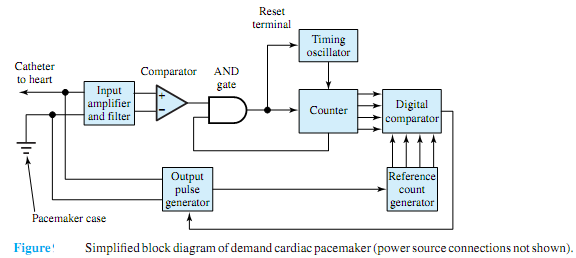Q. Explain working of Cardiac Pacemaker?
When blockage occurs to the biological signals that stimulate the heart to beat, the application of electric pacemaker pulses forcing the heart to beat at a higher rate is very helpful. A demand pacemaker is particularly helpful to the patient with partial blockage, in which case an electric pulse to the heart muscle is only applied when a beat does not occur within a predetermined time interval.
The pacemaker circuitry along with a lithium battery are enclosed in a metal case, which is implanted under the skin on the patient's chest. The mental case and the tip of the catheter (a wire enclosed in an insulating tube) form the electrical terminals of the pacemaker. A simplified block diagram of a typical demand pacemaker is shown in Figure.
The input amplifier amplifies the natural heart signals, which have a small amplitude on the order of 1 mV. Filtering eliminates certain frequency components so that heartbeats can be better detected. A comparative circuit is then used to compare the amplified and filtered signal with a threshold value and detect either a natural heartbeat or an output pacing pulse. This detection decision is passed on to the counting and timing circuitry through an AND gate. The second input to the AND gate comes from the counter circuit, such that input signals for 0.4 s after the start of a natural or forced beat are ignored.
The timing functions are performed by counting the output cycles of a timing oscillator, which generates a square wave with a precise period of 0.1 s. The digital signals produced by the counter are passed on to a digital comparator, which compares them with signals from a reference count generator and decides when the pulse generator is to deliver an output pulse of a specified amplitude and duration.

Extremely low power consumption and high reliability become important criteria for all pacemaker designs.While electrical engineers can come upwith better circuit designs,mechanical and chemical engineers have to select better materials to produce the case and the catheter, and above all, the physicians have to provide the pacemaker specifications.Thus, doctors and engineers have to work in teams in order to develop better biomedical products.